Question 1:
Mention the advantages of selecting pea plant for experiment by Mendel.
Answer:
Advantages of selecting pea plant as experimental material
Mendel selected pea plant (Pisum sativum) because:
1. Many varieties were available with observable alternative forms for a trait or
character.
2. Peas normally self pollinate; as their corolla completely enclose the reproductive organs
until pollination is completed.
3. It was easily available.
4. It has pure lines for experimental purpose, i.e., they always breed true.
5. It has contrasting characters. The traits were seed colour, pod colour, pod shape, flower
shape, position of flower, seed shape and plant height.
6. Its life cycle was short and produced large number of offsprings.
7. The plant is grown easily and does not require care except at the time of pollination.
Question 2:
Differentiate between Dominance and recessiveness
Answer:
Differences between dominance and recessiveness
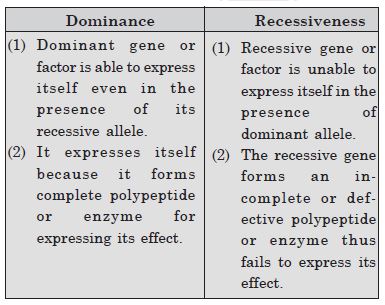
Question 3:
Differentiate between Homozygous and heterozygous individual.
Answer:
Differences between homozygous individual and heterozygous individual
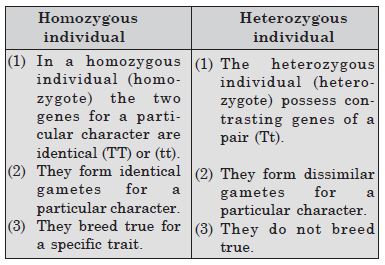
Question 4:
Differentiate between Monohybrid and dihybrid.
Answer:
Difference between monohybrid and dihybrid

Question 5:
A diploid organism is heterozygous for 4 loci, how many types of gametes can be produced?
Answer:
It will produce 16 types of gametes.
Question 6:
Explain the law of dominance using a monohybrid cross.
Answer:
Law of Dominance. According to this law, when two factors of a characters are unlike, one of
them will manifest in the body and is called dominant while the other remains hidden and is
termed recessive factor.
The law can be well explained by the monohybrid cross by studying the following crosses:
(i) Pure tall = TT, Hybrid tall = Tt

The 50% are pure tall and 50% hybrid tall. Then pure tall plants will produce 100% tall in
F2 generation and hybrid plants will produce in ratio of 1: 2: 1 in the F2
generation.
(ii) When the cross is made between pure tall and pure dwarf, we get results as follows (Fig.
5.3)
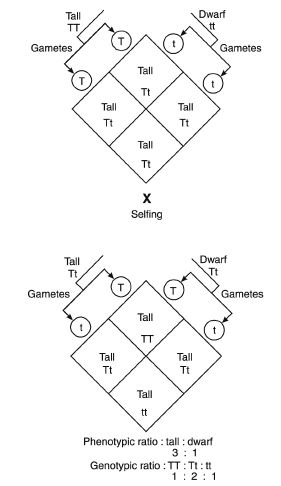
A Punnett square used to understand a typical monohybrid cross conducted by Mendel between
true-breeding tall plants and true-breeding dwarf plants.
Question 7:
Define and design a test cross.
Answer:
Test Cross. It is a cross between an organism of an unknown genotype and a homozygous
recessive organism.
Results of a Test Cross. If the test cross yields offspring of which 50% show the dominant
character and 50% show the recessive character, i.e.F1 ratio is 1: 1, the
individual under test is heterozygous (Fig. 5.2). This
is so because the individual showing the recessive trait (say white coat colour in guinea
pig, dwarf size in pea plant) must have received one recessive allele (b in guinea pig, t in
pea plant) from each parent.
If all the offspring of the test cross show the dominant trait, the individual being tested
in homozygous dominant with genotype BB for guinea pig and TT for pea plant.
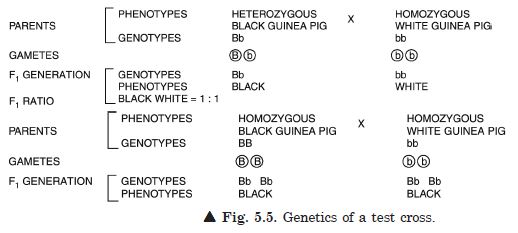
Question 8:
Using a Punnett Square, work out the distribution of phenotypic features in the first filial generation after a cross between a homozygous female and a heterozygous male for a single locus.
Answer:
Distribution of phenotypic features
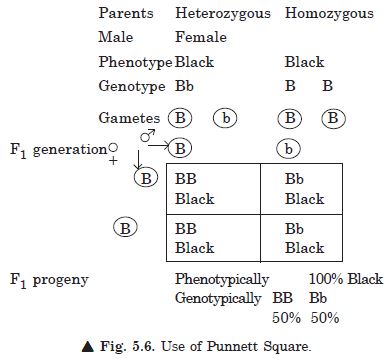
Question 9:
When a cross is made between tall plant with yellow seeds (TtYy) and tall plant with green
seeds (Ttyy), what proportions of phenotype in the offspring could be expected to be
(a) tall and green
(b) dwarf and green?
Answer:
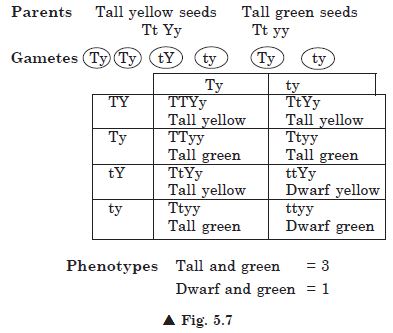
Question 10:
Two heterozygous parents are crossed. If the two loci are linked what would be the distribution of phenotypic features in F1 generation for a dihybrid cross?
Answer:
In such a cross recombinants should not appear due to complete linkage. All the offsprings
should have parental type. The ratio obtained will are 1: 1: 1: 1 instead of 9: 3: 3: 1. The
linked genes do not assort independently.
However in case of incomplete linkage parental combinations will be more and new
combinations will be less in number.
Question 11:
Briefly mention the contribution of T.H. Morgan in genetics.
Answer:
Morgan called the father of experimental genetics T.H. Morgan, an American Zoologist started
the experimental genetics. His important discoveries are:
1. He proved that genes are located on chromosomes with his experiments on Drosophila.
2. Morgan discovered criss-cross inheritance.
3. He also discovered mutability of genes.
4. He described linkage, crossing over, chromosome mapping and also proposed chromosome
theory of linkage.
He was awarded Nobel Prize in 1933.
Question 12:
What is pedigree analysis? Suggest how such an analysis can be useful ?
Answer:
Pedigree Analysis. Study of family record, for following the inheritance and distribution of
certain genetic traits in human beings. Pedigree analysis is also used for domestic animals,
especially the pets.
Two main tools employed in pedigree analysis
1 Principle of probability and chances of differences in realised ratio due to smallness of
the progeny.
2. Elimination of alternatives. Significance of pedigree analysis
1. It is useful for the genetic counsellors to advise intending couple about the possibility
of having children with genetic defects.
2. It indicates that Mendelian principles are applicable to human genetics with some
modification.
3. It enables the study of pedigree for the transmission of character and finding the
absence or presence of that trait in homozygous or heterozygous state.
Question 13:
How is sex determined?
Answer:
Determination of the sex of child. Sex chromosomes determine sex in human beings. In males,
there are 44 + XY chromosomes, whereas, in female there are 44+XX chromosomes. Here X and
Y chromosomes determine sex in human beings. Two type of gametes are formed in male, one
type is having 50% X-chromosome, whereas, other type is having Y-chromosome. In female
gametes are of one type and contain X-chromosome. Thus females are homogametic. If male
gamete having Y-chromosome (androsperm) undergoes fusion with female gamete having
X-chromosome, the zygote will have XY-chromosome and this gives rise to male child.
If male gamete having X-chromosome (gynosperm) undergoes fusion with female gamete having
X-chromosome, the zygote will be having XX-chromosome and this gives rise to female
child.
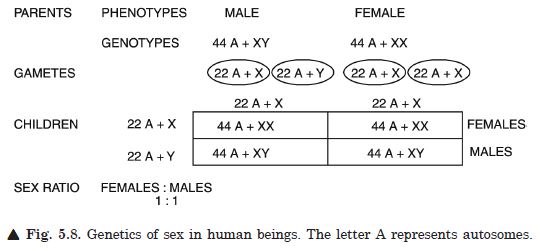
Question 14:
Child has blood group O. If the father has blood group A and mother blood group B, work out the genotypes of the parents and the possible genotypes of the other offsprings.
Answer:
(a) Genotypes. Man (IAIO) Mother IBIO and Child
IOIO.
(b) Blood group of the future offspring. A type, B type, O type and AB type. It is based on
the following cross:
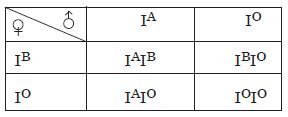
Question 15:
Explain the following terms with example:
(a) Codominance
(b) Incomplete dominance.
Answer:
(a) Codominance. Independent expression of two alleles in an individual is termed
codominance. The alleles which are able to express themselves independently but when present
together are called codominant alleles. As a result the heterozygous condition, the
phenotype different from either of a homozygous condition. The joint character may appear to
be intermediate between the two homozygous parents.
In codominance, a heterozygote shows a phenotypic difference from that shown by either of
the homozygotes. The codominant alleles are shown by the same capital letter with different
super-scripts, e.g. IA, IB.
Example. The alleles IA and IB of human blood groups are said to be
codominant because both are expressed in the phenotype AB. Each produces its antigen and
neither checks the expression of the other.
(b) Incomplete dominance. Expression of heterozygous alleles, different from those of the
parents, producing distinguishable hybrids is called incomplete dominance. In this case none
of the two contrasting
genes or factors is dominant, rather it is intermediate or a fine mixture of the expression
of the two factors. It is also called partial or mosaic inheritance. Incomplete dominance is
not an example of blending
inheritance because the parental characters reappear as is evident when F1 hybrids are
selfed, the genotypic and phenotypic ratio is 1: 2: 1. The alleles of the genes are
therefore discrete or particulate.
Examples of incomplete dominance
1. Flower colour in Snapdragon. Mirabilis jalapa
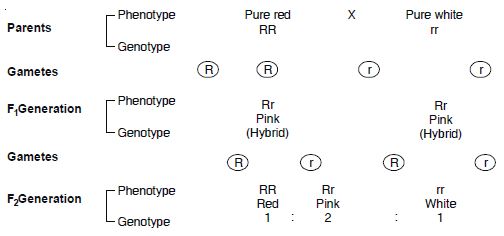
2. Andulusian fowls have two pure forms black and white. If the two forms are crossed
F1 individuals are blue coloured which on selfing produce black, blue and white in
the ratio of 1: 2: 1 in F2 generation.
Question 16:
What is point mutation? Give one example.
Answer:
Mutation term is now used in rather strict sense to cover only those changes which alter the
chemical structure of gene at molecular levels. Mutation is a recurrent event because a
given length of DNA can undergo only a limited number of chemical changes. Mutation arising
due to a change in single base pair of DNA is called point mutation.
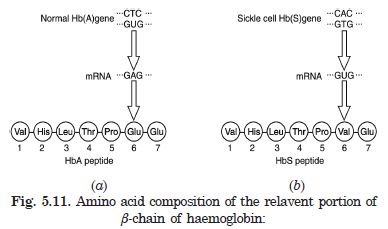
(a) From a normal individual; (b) From an individual with sickle cell anaemia showing point
mutation. The human disorder called sickle cell anaemia is caused by a single base substitution
in a gene. This alteration results in the replacement of glutamic acid by valine at position 6
in the polypeptide chain of haemoglobin, making the latter haemoglobin S. The disorder is
manifested only in homozygous recessive state (HbS, HbS). It kills the victim by the age of 20
years.
Question 17:
Who had proposed the chromosomal theory of the inheritance?
Answer:
Sutton and Boveri proposed the chromosome theory of inheritance in 1902.
Question 18:
(a) Mention any two autosomal genetic disorders. (b) What is Down’s syndrome? Give its symptoms and cause. Why is it that the chances of having a child with Down’s syndrome increases if the age of the mother exceeds forty years?
Answer:
(a) 1. Down’s syndrome and 2. Alkaptonuria.
1. Down’s syndrome. It is a case of autosomal aneuploidy. It is caused due to trisomy of
21st chromosome. Such individuals are aneuploids and have 47 chromosomes due to
non-disjunction.
Symptoms:
1. Mongolian eyelid fold
2. Ever open mouth
3. Protruding tongue
4. Short neck
5. Projecting lower lip.
The chances of having a child with Down’s syndrome increase with the age of the mother (+40)
because ova are present in females. Since their birth and therefore older cells are more
prone to chromosomal non-disjuction because of various physico-chemical exposures during the
mother’s lifetime.
Hence the chances of Down syndrome (Trisomy of 21st chromosome are more.)
2. Alkaptonuria. It is a case of autosomal gene mutation. It is caused due to absence or
inactivity of enzyme homogentisic oxidase.
Symptoms:
1. Blackening of urine on exposure to air
2. Darkening of cartilage.
